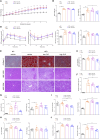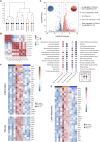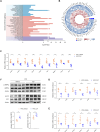Clopidogrel ameliorates high-fat diet-induced hepatic steatosis in mice through activation of the AMPK signaling pathway and beyond
- PMID: 39508046
- PMCID: PMC11537861
- DOI: 10.3389/fphar.2024.1496639
Clopidogrel ameliorates high-fat diet-induced hepatic steatosis in mice through activation of the AMPK signaling pathway and beyond
Abstract
Introduction: Metabolic dysfunction-associated steatotic liver disease (MASLD) frequently confers an increased risk of vascular thrombosis; however, the marketed antiplatelet drugs are investigated for the prevention and treatment of MASLD in patients with these coexisting diseases.
Methods: To determine whether clopidogrel could ameliorate high-fat diet (HFD)-induced hepatic steatosis in mice and how it works, mice were fed on normal diet or HFD alone or in combination with or without clopidogrel for 14 weeks, and primary mouse hepatocytes were treated with palmitate/oleate alone or in combination with the compounds examined for 24 h. Body weight, liver weight, insulin resistance, triglyceride and total cholesterol content in serum and liver, histological morphology, transcriptomic analysis of mouse liver, and multiple key MASLD-associated genes and proteins were measured, respectively.
Results and discussion: Clopidogrel mitigated HFD-induced hepatic steatosis (as measured with oil red O staining and triglyceride kit assay) and reduced elevations in serum aminotransferases, liver weight, and the ratio of liver to body weight. Clopidogrel downregulated the expression of multiple critical lipogenic (Acaca/Acacb, Fasn, Scd1, Elovl6, Mogat1, Pparg, Cd36, and Fabp4), profibrotic (Col1a1, Col1a2, Col3a1, Col4a1, Acta2, and Mmp2), and proinflammatory (Ccl2, Cxcl2, Cxcl10, Il1a, Tlr4, and Nlrp3) genes, and enhanced phosphorylation of AMPK and ACC. However, compound C (an AMPK inhibitor) reversed enhanced phosphorylation of AMPK and ACC in clopidogrel-treated primary mouse hepatocytes and alleviated accumulation of intracellular lipids. We concluded that clopidogrel may prevent and/or reverse HFD-induced hepatic steatosis in mice, suggesting that clopidogrel could be repurposed to fight fatty liver in patients.
Keywords: AMPK; MASLD; NAFLD; clopidogrel; fatty liver; hepatic steatosis; steatotic liver.
Copyright © 2024 Tai, Shao, Zheng, Jiang, Han, Yin, Li, Ji, Mi, Yang, Feng, Duan and Xie.
Conflict of interest statement
The authors declare that the research was conducted in the absence of any commercial or financial relationships that could be construed as a potential conflict of interest.
Figures




Similar articles
-
Gracilaria chorda subcritical water ameliorates hepatic lipid accumulation and regulates glucose homeostasis in a hepatic steatosis cell model and obese C57BL/6J mice.J Ethnopharmacol. 2024 Feb 10;320:117395. doi: 10.1016/j.jep.2023.117395. Epub 2023 Nov 11. J Ethnopharmacol. 2024. PMID: 37952731
-
Gut Dysbiosis Shaped by Cocoa Butter-Based Sucrose-Free HFD Leads to Steatohepatitis, and Insulin Resistance in Mice.Nutrients. 2024 Jun 18;16(12):1929. doi: 10.3390/nu16121929. Nutrients. 2024. PMID: 38931284 Free PMC article.
-
Atractylodes Lancea and Its Constituent, Atractylodin, Ameliorates Metabolic Dysfunction-Associated Steatotic Liver Disease via AMPK Activation.Biomol Ther (Seoul). 2024 Nov 1;32(6):778-792. doi: 10.4062/biomolther.2024.083. Epub 2024 Oct 11. Biomol Ther (Seoul). 2024. PMID: 39391981 Free PMC article.
-
Polyoxometalates Ameliorate Metabolic Dysfunction-Associated Steatotic Liver Disease by Activating the AMPK Signaling Pathway.Int J Nanomedicine. 2024 Oct 25;19:10839-10856. doi: 10.2147/IJN.S485084. eCollection 2024. Int J Nanomedicine. 2024. PMID: 39479173 Free PMC article.
-
P2Y2R Deficiency Ameliorates Hepatic Steatosis by Reducing Lipogenesis and Enhancing Fatty Acid β-Oxidation through AMPK and PGC-1α Induction in High-Fat Diet-Fed Mice.Int J Mol Sci. 2021 May 24;22(11):5528. doi: 10.3390/ijms22115528. Int J Mol Sci. 2021. PMID: 34073834 Free PMC article.
Cited by
-
Rhizoma Atractylodis Macrocephalae reduces HFD-induced MAFLD in mice through activated AMPK-mediated inhibition of fatty acid synthesis.Liver Res. 2025 Apr 15;9(2):157-168. doi: 10.1016/j.livres.2025.04.004. eCollection 2025 Jun. Liver Res. 2025. PMID: 40620498 Free PMC article.
References
-
- Anonymous (2024). FDA approves first treatment for patients with liver scarring due to fatty liver disease. Available at: https://www.fda.gov/news-events/press-announcements/fda-approves-first-t... (Accessed August 16, 2024).
LinkOut - more resources
Full Text Sources
Research Materials
Miscellaneous

